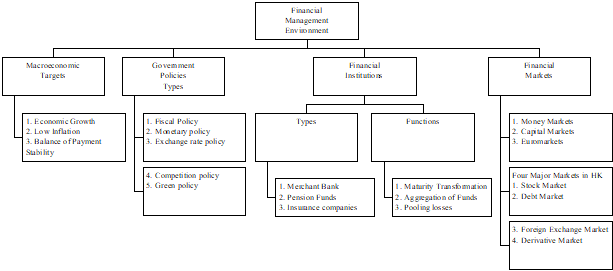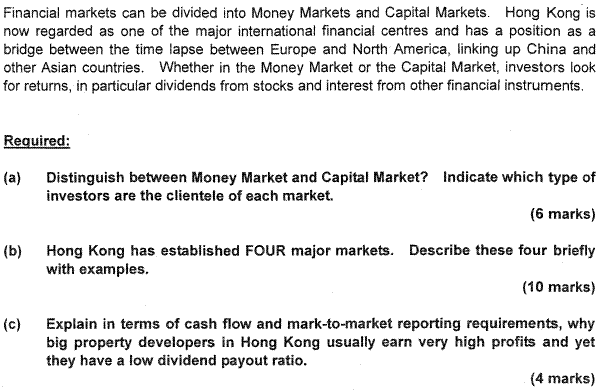Chapter 13 Financial Management Environment
LEARNING OBJECTIVES 1. Briefly describe the types of government objectives for the economy. |

1. Macroeconomic Targets
1.1 Government objectives for the economy are referred to as macroeconomic objectives or targets. The three main targets are usually:
(a) Economic growth and high employment
(b) Low inflation
(c) Balance of payments stability
1.2 Policies for achieving macroeconomic targets
Policy type |
Definition |
Fiscal policy |
How much the government decides to spend, and to raise as tax revenue |
Monetary policy |
Control over the money supply and of interest rates |
Exchange rate policy |
If the value of the local currency is forced down in value it makes imports more expensive and exports cheaper |
Competition policy |
Policies to encourage competition, e.g. blocking takeovers |
Green policy |
Policies to encourage protection of the environment |
1.3 Types of inflation
(a) Demand-pull inflation – As supply and demand analysis indicates, prices begin to rise when demand for final goods and services and factors of production increase.
(b) Cost-push inflation – Business costs rise at a time of excess demand because of shortages for certain factors of production. Costs can also rise when demand is weaker due to increased import prices.
(c) Imported inflation – It is caused by rising import prices resulting from a fall in the value of the local currency.
(d) Monetary inflation – It results through over-expansion of money supply.
1.4 Problems of high inflation
(a) Undermines business confidence – Businesses fear the higher interest rates which accompany times of high inflation. Higher rates raise borrowing costs and lower profits. This makes businesses hesitant about new investment projects.
(b) Erodes of living standards – Wage demands follow a rise in inflation, as workers try to protect living standards. This can actually cause further inflation.
(c) Discourages saving – When inflation exceeds the rate of return on savings, savers actually lose the money by saving. Saving is needed to provide funds for capital investment.
(d) Damages export performance leading to import penetration – As goods become more expensive, it becomes harder to sell them overseas and domestic residents are more likely to buy imported goods.
(e) Leads to loss of faith in the currency – If inflation gets out of hand, people may lose confidence in the value of money and stop using it to exchange goods and services.
2. Financial Institutions
2.1 Types of financial institutions
Types |
Functions |
Merchant banks |
Provide large corporate loans, often syndicated. Manager investment portfolios for corporate clients |
Pension funds |
Invest to meet future pension liabilities. |
Insurance companies |
Invest to meet future liabilities. |
2.2 Financial intermediaries provide the following functions:
Functions |
Descriptions |
Maturity transformation |
A bank can make a 10-year loan (long-term) while still allowing its depositors to take money out whenever they want; so short-term deposits become long-term investments. |
Aggregation of funds |
A bank can aggregate lots of small amounts of money into a large loan. |
Diversification of risk |
Many individuals may be scared of lending money directly to one particular company because of that company going bankrupt. A bank will be lending money to many companies and will therefore be reducing the risk to themselves and therefore to the individuals whose money they are using. |
3. Financial Markets
3.1 A financial market brings a firm into direct contact with its investors. The trend to borrowing directly from investors is sometimes called disintermediation.
3.2 Financial markets are split into those that provide short-term finance (money markets) and those that provide long-term finance (capital markets).
3.3 Money markets – If a company or a government needs to raise funds for short-term, they can access the money markets and issue: Less than 1 year (Dec 09, Dec 10)
Increasing risk to the investor |
|
(a) Treasury bills (issued by governments) |
(b) Certificates of deposit (issued by companies) |
||
(c) Commercial paper (issued by companies with a high credit rating) |
||
(d) Bills of exchange |
3.4 Capital markets – If a company needs to raise funds for the long-term, it can access the capital markets; this is a market on which the following are traded:
(Dec 09, Dec 10)
Increasing risk to the investor |
|
(a) Debentures/loan notes (secured on an asset or by covenants) |
(b) Junk bonds (unsecured) |
||
(c) Shares traded on the main stock market |
||
(d) Shares in Alternative Investment Market |
3.5 Higher risk investments require a higher return to be paid, so shares will give a higher return (and therefore cost more) than debentures.
3.6 Euromarkets – In recent years a strong market has built up which allows large companies with excellent credit ratings to raise finance in a foreign currency. This market is organised by international commercial banks. The key features of Eurobonds are summarised below. This market is much bigger than the market for domestic bonds / debentures.
Advantages |
Explanation |
Cheap debt finance |
Can be sold by investors, and a wide pool of investors share the risk |
Unsecured, no covenants |
Only issued by large companies with an excellent credit rating |
Long-term debt in a foreign currency |
Typically 5 – 15 years, normally in euros or dollars but possible in any currency |
3.7 Four major markets in Hong Kong: (Dec 09, Jun 15)
(a) The Hong Kong Stock Market – This allows to trade stocks in the Hong Kong Stock Exchange and is one of the most actively traded markets in the world in terms of trading volume and market capitalization.
The stock market index, such as Hang Send Index, is computed from the prices of selected stocks to measure the value of a section of the stock market. The industries included in the Hang Seng Index include finance, utilities, properties and commerce and industry.
(b) The Hong Kong Debt Market – This is also known as the fixed income market. It allows the trading of fixed income products like bonds and notes. Compared with the Stock Market, its trading volume is comparatively small.
(c) The Foreign Exchange Market – Hong Kong does not have exchange control and it allows the trading of foreign currency. People can make use of computer systems in trading and a physical establishment is not required.
(d) The Derivative Market – Hong Kong has an active derivative market for the trading of forwards, futures and warrants. The market provides speculative and hedging functions and the former far exceeds the latter.
(e) The Commodity Market – It facilitates the trading of commodities, such as oil, metals and agricultural produce.
3.8 Primary markets enable organizations to raise new finance, by issuing new shares or new bonds. In the UK, a company must have public company status to be allowed to raise finance from the public on a capital market.
3.9 Secondary markets enable investors to buy and sell existing investments to each other.
3.10 Secondary markets may be organized on exchanges or may consist of over the counter (OTC) transactions.
Examination Style Questions
Question 1
Discuss the role of financial intermediaries in providing short-term finance for use by business organisations. (4 marks)
(ACCA F9 Financial Management December 2009 Q4(a))
Question 2
Taxes, among others, are often used as part of the government’s fiscal policy to achieve various economic objectives. What are the economic objectives for reducing taxes? What economic impacts do you think a reduction of taxes will have on the local economy?
(5 marks)
(HKIAAT PBE Paper III Financial Management June 2007 Q3(c))
Question 3
Inflation is always under close scrutiny of both the government and companies as it is common in a growing economy but could cause serious economic problems if out of control.
Required:
(a) Briefly discuss three sources of inflation. (3 marks)
(b) Briefly discuss three potential problems of inflation. (3 marks)
(c) How may inflation affect the financial markets and the growth of the economy respectively? (4 marks)
(HKIAAT PBE Paper III Financial Management June 2007 Q4(b))
Question 4
What are the appropriate fiscal policies the government can pursue if the economy is in a serious recession? What if the economy is “overheated”? (5 marks)
(HKIAAT PBE Paper III Financial Management December 2002 Q6(b))
Question 5

(Total 20 marks)
(HKIAAT PBE Paper II Management Accounting and Finance December 2009 Q3)
Question 6
What are the main differences between Capital Market and Money Market? (3 marks)
(HKIAAT PBE Paper II Management Accounting and Finance December 2010 Q3(f)
Question 7
Financial markets consist of several types of categories.
Required:
(a) Name and briefly describe FOUR different types of financial markets in an international financial centre. (8 marks)
(b) The stock market index is a measure of stock market performance. (i) Suggest one limitation of the stock market index in measuring stock market performance, and (ii) name THREE major industries that you can find in the Hang Seng Index. (4 marks)
(HKIAAT PBE Paper II Management Accounting and Finance June 2015 Q4(a) & (b))
Source: https://hkiaatevening.yolasite.com/resources/PBEP2Notes/Chapter13-FMEnviron.doc
Web site to visit: https://hkiaatevening.yolasite.com
Author of the text: indicated on the source document of the above text
If you are the author of the text above and you not agree to share your knowledge for teaching, research, scholarship (for fair use as indicated in the United States copyrigh low) please send us an e-mail and we will remove your text quickly. Fair use is a limitation and exception to the exclusive right granted by copyright law to the author of a creative work. In United States copyright law, fair use is a doctrine that permits limited use of copyrighted material without acquiring permission from the rights holders. Examples of fair use include commentary, search engines, criticism, news reporting, research, teaching, library archiving and scholarship. It provides for the legal, unlicensed citation or incorporation of copyrighted material in another author's work under a four-factor balancing test. (source: http://en.wikipedia.org/wiki/Fair_use)
The information of medicine and health contained in the site are of a general nature and purpose which is purely informative and for this reason may not replace in any case, the council of a doctor or a qualified entity legally to the profession.
The texts are the property of their respective authors and we thank them for giving us the opportunity to share for free to students, teachers and users of the Web their texts will used only for illustrative educational and scientific purposes only.
All the information in our site are given for nonprofit educational purposes